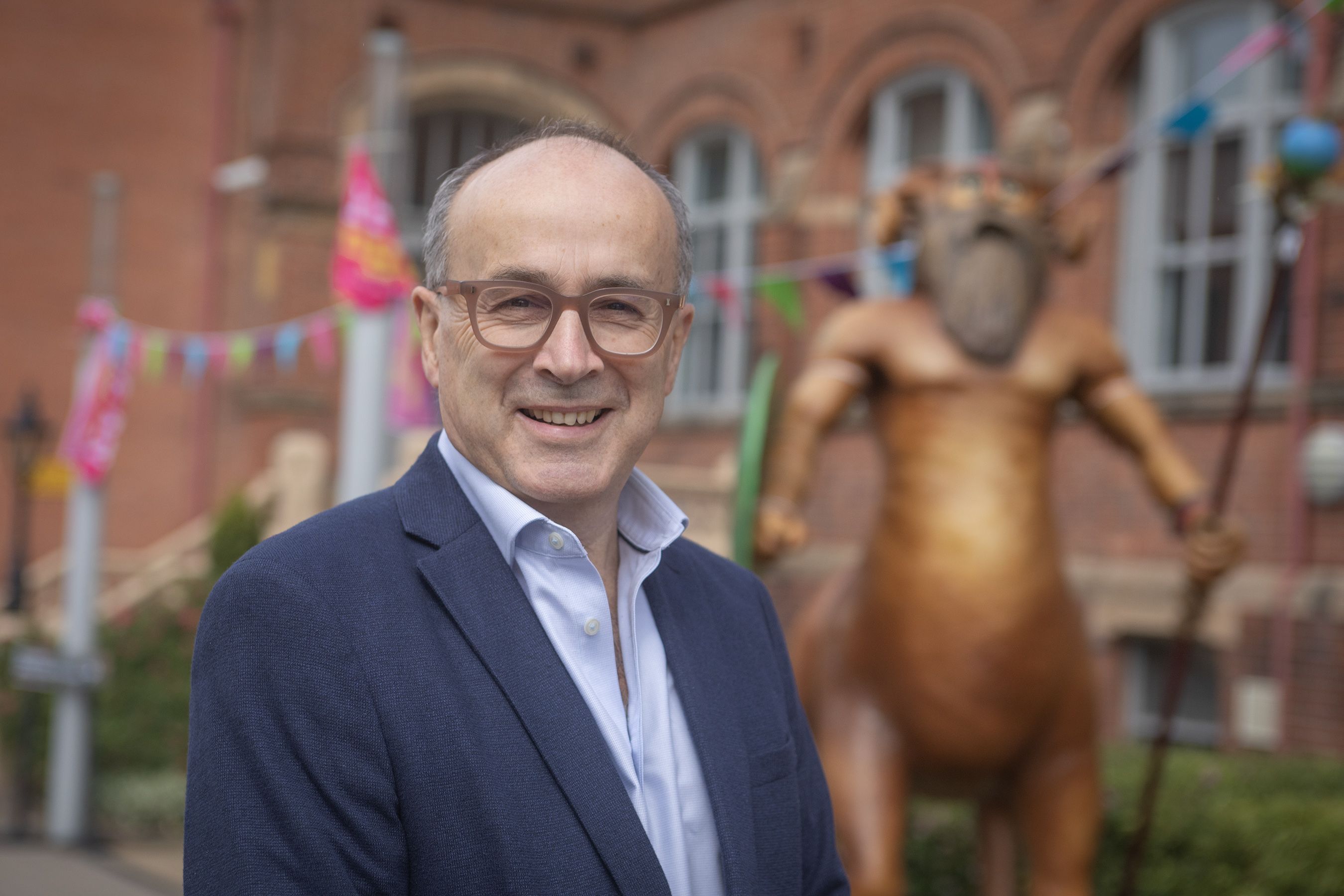AN English doctor who was in Belfast this week to speak at a Féile an Phobail event has described parts of Gaza as "post-apocalyptic".
Professor Nick Maynard is a consultant gastrointestinal surgeon at Oxford University Hospital in England and has been visiting Gaza at least once a year since 2010. He returned from Gaza ten days ago, after spending a month working at the Nasser Hospital in Khan Yunis. Before his most recent visit he was last in Gaza in July last year. However, over those 13 months, he says, the situation has become even more harrowing.
“I didn’t believe it could be worse after all I’d seen last year and I’d been in touch regularly with all my friends and colleagues out there so I thought I’d be prepared. I thought I’d know what to expect but it is much worse than I expected,” he said in an interview with the Andersonstown News.
Prof Maynard was invited to Ireland by Trócaire to share his experiences of what is happening in the stricken region with local audiences. He said that while the relentless trauma, explosions and bombings are similar to his previous two visits since the Israeli invasion, malnutrition is much worse than last year, while he described the multiple shootings at the Gazan Humanitarian Foundation food distribution sites as “barbarism”.
“I saw so many people die: Babies, children, adults, as a direct result of malnutrition. It was awful. The terrible shootings I saw at the food sites are just indescribable.
“Enough of my friends and colleagues – local healthcare workers – have gone to them to get food for their starving families,” he said. “They've been designed to create chaos, to create riots, and are called death-traps and I understand why they are called death-traps. Young teenage boys, sometimes not even teenage, sometimes 11 or 12, 13, 14, they go there to collect food for their starving families.
"There is enough food for about 300 people in the compound. It’s locked. They wait until 3 to 4,000 Gazans have collected outside. They open up a small gate and suddenly you’ve got 3 to 4,000 people trying to get in to get enough food to feed ten per cent of the people.
"So, it’s designed to create maximum chaos, rioting. There’s fighting, there are criminal gangs there who are trying to steal the food and sell it on the black market. I’ve seen colleagues of mine come back with cuts, grazes, bruises, everything. And what is then happening is that the Israeli soldiers are systematically shooting dozens – one day nearly one hundred young teenage boys at these food sites.”
He said that the Israelis are using quadcopters to fire on civilians at the food sites.
“I’d been there (in Gaza) about five days or four days and the very first victim I saw from one of these food sites who had been shot was a 12-year-old boy who died on the operating table because his injuries were so severe, the bullet had transected his abdominal aorta,” he said.
“So, he died on the operating table and what was even more distressing from these multiple injuries was the very clear recognition of these patterns of clustering of injuries. So you’d get particular body parts that would be shot on particular days. So, on one day, you’d get sometimes up to 20 young teenage boys brought in with gunshot wounds to the head and the next day it would be the chest; the next day it would be abdomen; the next day the legs; the next day the arms. One day we had four kids, four young teenage boys all brought in, all of them who had been shot in the testicles.
"The clustering and the patterns we recognised were far too striking for there to be any chance of coincidence and there was a very clear impression we got that they were almost playing a game of target practice. 'Right, we’re going to go for the head today; we’re going to go for the abdomen tomorrow; Saturday we’re going to go for the testicles.' It’s barbaric. I would not have believed that would have been possible unless I witnessed the results of that.”
Prof Maynard described the medical staff he worked with over the four weeks in Gaza as inspirational.
“They are starving, they’re all hungry,” he says. “I’ve met surgeons who I’ve known before who lost 35 to 40 kilograms in weight. Some of them are barely recognisable. They are hungry the whole time. When they leave the hospital they go back to a tent, not even a tent actually, it’s a shelter with a tarpaulin covering it. And their wives and children are living there, starving.
“So they have to go and work, sometimes 24-hour shifts, and then have to go to one of these food distribution sites and try and get some food and get into fights to try and get it. It is indescribably awful and these are people who are still working incredibly hard. They are some of the most inspirational people I’ve ever met in my life, working to try and save their fellow Gazans despite the fact that they are hungry. They are weak, they are getting illnesses the whole time because they are so weak and malnourished but heroically still working.”
He says that many patients who should be surviving operations are dying because they are so malnourished.
“A lot of them have major injuries but they are predominantly young people and you would expect them to have a 95 per cent chance of surviving most of these injuries if they were otherwise fit or healthy, but they are at a much greater risk of getting complications because they are malnourished. They are immuno-suppressed. Their tissues don’t heal, so the terrible damage to their internal organs from the bullets or the shrapnel from the bombs, we laboriously repair all the internal damage, but the bodies don’t heal because they haven’t had the nutrition. Their immune system is not working properly. So all those repairs break down and leak and cause terrible infections.”
He has witnessed malnourished children sitting in the street staring into space “as if their whole psyche has been stunned”.
“The adults all want to get out, they all want to leave,” he says. “Their will has been broken. They are the most resilient people I’ve ever met in my life, but they’ve had enough. They owe it to their wives and children. But they hope they’ll come back eventually when the world sorts out Israel and allows Gaza to rebuild, but they want to get out.”
Prof Maynard said that Khan Yunis where he was working is "largely completely destroyed but nothing as like it is the north". His route home two weeks ago took him close to the north of Gaza, just south of Gaza City.
"It was like the post-apocalyptic world we saw in the Mad Max movie. It was just like that. I could not believe what I was seeing. Everything had been destroyed and it was horrible."
Professor Maynard was interviewed by the Andersonstown News
In recent days Netanyahu has threatened to escalate the Israeli offensive in Gaza. The United Nations has warned that such an action would have "catastrophic consequences".
“My great fear is what has been my fear for a long time now because I’ve never doubted in my mind what Netanyahu and his right wing government’s end game is – to ethnically cleanse Gaza and to get settlers in there," said Professor Maynard. "I’ve always believed that was his end game.
“This idea that it is all about getting rid of Hamas and getting the hostages back, I never believed that for a second. And I very naively thought that all the world would stand up to Netanyahu and stop him doing that, but even though there are so many millions of supporters of Gaza around the world, now that the world’s woken up our governments are still supporting Israel, so I fear they’re going to be allowed to carry on with this.
"And Netanyahu only yesterday said that his clear aim is to get Gazans out of Gaza, so that is my great fear."
Prof Maynard works with Trócaire’s partner organisation Medical Aid for Palestinians.
Peter Heaney, Trócaire's Head of Region for the North of Ireland, said: "Trócaire has supported Medical Aid for Palestinians since 2024 with life-saving support for people in the Gaza Strip. This support has included essential medical supplies and crucial nutrition support for women and children.
"Medical Aid for Palestinians and Trócaire’s other partners in Gaza have provided humanitarian aid in unimaginable circumstances for both their teams and the population of Gaza, where access is constrained, safety is at risk and targeting of medical facilities is common."






